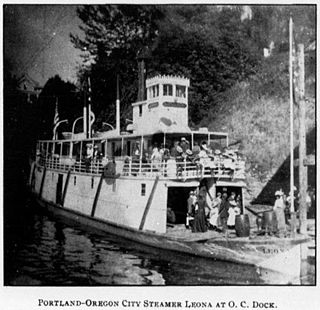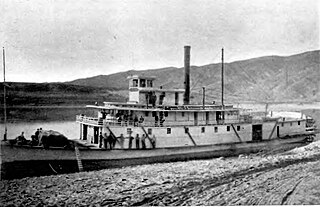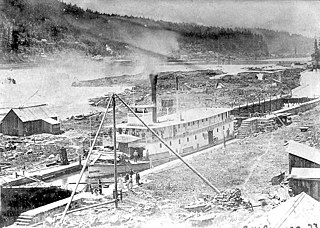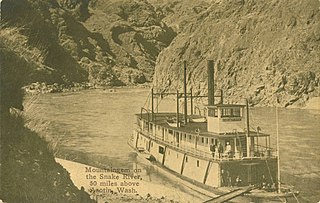
Lining was a method used by steamboats to move up river through rapids. Lining could also be used to lower steamboats through otherwise impassible falls.

Lining was a method used by steamboats to move up river through rapids. Lining could also be used to lower steamboats through otherwise impassible falls.
Lining involved running a rope, called a line or a steel cable to a secure point on shore, typically a large tree or a bolt specially set in a rock, and then wrapping the cable around a steam-powered winch on the boat. The winch would then crank in the cable, if the vessel was going upstream, or gradually let out the cable, if the vessel was headed downstream. [1]
Along the Willamette River, in the first decades of the 1900s, the most dangerous obstacles to navigation were Willamette Falls and the Clackamas Rapids. Since 1873 locks at Oregon allowed navigation around Willamette Falls, but as late as 1907, lining was still required to pass the Clackamas Rapids, which were located north of Oregon City, near the mouth of the Clackamas River.
Lining was dangerous, as it was only the single cable that prevented the vessel from being washed downstream and likely wrecked. Any use of a cable on board a vessel was also hazardous to the crew. On October 15, 1907, at 8:30 am, while Oregona was lining through Clackamas Rapids, the lining cable became tangled in the sternwheel of a nearby steamer, the Ruth. A deckhand on Oregona, Virgil K. Pollard, was caught in a loop of the cable, which tightened around his legs, severing both legs six inches (15 cm) above the ankles. [2] The injured deckhand brought a legal action against the Ruth.
When the case was presented to U.S. District Court Judge Robert S. Bean, he ruled that accident was held to be the fault of the Ruth, for ignoring the warning signals of the Oregona to stand away while the deckhand was engaged in coiling the cable which was still paid out from the Oregona following an unsuccessful lining attempt. Judge Bean awarded the deckhand, who was 19 years of age at the time of the accident, $12,000 in damages. [3]
Steamboats operated on the Wenatchee Reach of the Columbia River from the late 1880s to 1915. The main base of operations was Wenatchee, Washington, located at the confluence of the Wenatchee and Columbia Rivers, 465 miles (748 km) from the mouth of the river. Operations were mainly between Wenatchee and Bridgeport. Rapids below Wenatchee and above Bridgeport prevented safe navigation.

The steamship Altona operated from 1890 to 1907 on the Willamette River in the U.S. state of Oregon. In 1907, she was transferred to Alaska.

The steamship Leona operated from 1899 to 1912 on the Willamette River in the U.S. state of Oregon. This vessel was original launched under the name McMinnville in 1899, and should not be confused with an earlier vessel named McMinnville, which ran on the Willamette River from 1877 to 1881.

Nez Perce Chief was a steamboat that operated on the upper Columbia River, in Washington, U.S., specifically the stretch of the river that began above the Celilo Falls. Her engines came from the Carrie Ladd, an important earlier sternwheeler. Nez Perce Chief also ran up the Snake River to Lewiston, Idaho, a distance of 141 miles from the mouth of the Snake River near Wallula, Wash. Terr.

Annie Faxon was a steamboat that was built by the Oregon Steam Navigation Company. She is chiefly remembered now for the catastrophic boiler explosion in 1893 that destroyed her and killed eight people on board.

The Belle of Oregon City, generally referred to as Belle, was built in 1853, and was the first iron steamboat built on the west coast of North America.

The Willamette Steam Navigation Company (W.S.N.) was an American company incorporated in October 1865 to challenge the monopoly on Willamette River inland steam navigation that the People's Transportation Company was attempting to establish.

Onward was an early steamboat on the Willamette River built at Canemah, Oregon in 1858. This vessel should not be confused other steamboats named Onward, including in particular the Onward of 1867, a similar but somewhat smaller vessel built at Tualatin Landing, which operated on the Tualatin River under Capt. Joseph Kellogg.

Echo was a sternwheel steamboat that operated on the Willamette River from about 1865 to 1873 and was one of the first steamboats to carry what was then considered a large cargo out of Eugene, Oregon.

The river sternwheeler Ramona operated from 1892 to 1908 on the Willamette River in Oregon, on the Stikine River running from Wrangell, Alaska into British Columbia, and the Fraser River, in British Columbia. This vessel should not be confused with the coastal steamship Ramona which also ran in Alaskan waters.

Governor Grover was a sternwheel steamboat that ran on the Willamette River during the 1870s. Because of the completion of the Willamette Locks in late 1872, it was possible for vessels such as Governor Grover to be built in Portland, Oregon and then readily navigate the Willamette above Willamette Falls.

The steamboat Oregona operated on the Willamette River, the Columbia River and the Yamhill River from 1904 to 1936. From 1924 to 1936 this vessel was known as the Interstate.

Grey Eagle was a wooden sternwheel-driven steamboat that operated on the Willamette and Yamhill rivers in the United States from 1894 to 1930. In 1903 Grey Eagle became the last commercial steamboat to run upriver to Junction City, Oregon.

The Upper Willamette Transportation Line was a line of four inland steamboats that operated from the fall of 1859 to the summer of 1860 on the upper Willamette River in the state of Oregon.

Moose was a steamboat that operated on the Willamette River from late 1859 to 1861.

Oregon was a side-wheel driven steamboat that operated on the Willamette River in the state of Oregon from 1852 to 1854. The steamer was not economically successful and became a total loss by sinking after a short career.

Senator was a stern-wheel-driven steamboat which operated on the Willamette River in the state of Oregon from 1863 to 1875. Senator is chiefly remembered for its having been destroyed in a fatal boiler explosion in 1875 while making a landing at the Portland, Oregon waterfront in 1875.

Active was a stern-wheel driven steamboat that operated on the upper Willamette River from 1865 to 1872. During its short operational life, Active was owned by several different steamboat companies. It was dismantled in 1872 at Canemah, Oregon.

Mountain Gem was a sternwheel-driven steamboat that operated on the Snake and Columbia rivers from 1904 to 1912, when the machinery was removed and installed in a different, newly built steamboat. Mountain Gem remained on the U.S. merchant vessel registry until 1922 or later. Although Mountain Gem was not abandoned until 1924, there is no evidence it was used after 1912.

Surprise was a steamboat which operated on the upper Willamette River from 1857 to 1864.